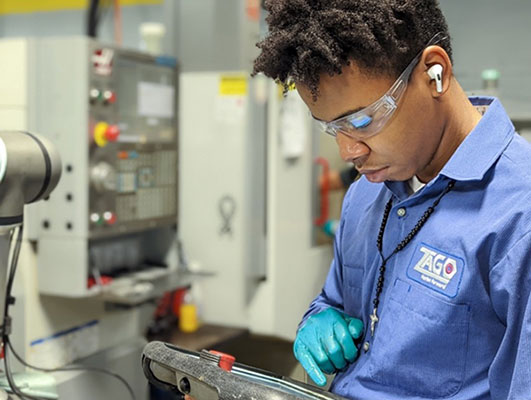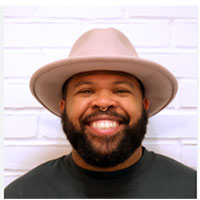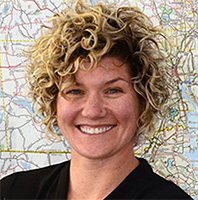Creating a diverse manufacturing workforce means raising awareness of the careers available in the sector.
by Aarin B. Clemon’s, Workforce Coordinator, and Lindsey Brickle, Senior Workforce Manager, at Polaris MEP in Rhode Island.
The manufacturing industry continues to struggle with hiring qualified workers. There are many unfilled positions due to a lack of awareness of the wide range of careers available in manufacturing. With new technologies emerging daily, the skills required to fill these manufacturing positions change as well. Many high schools and community colleges have stopped offering trade education, which adds to the deficit in the manufacturing workforce.

This increasing deficit means that the hiring process needs to evolve with the current times. If an employer is having trouble even getting applicants to apply to open positions, it is time to rethink their entire hiring process. This all starts with asking a few questions before an open job is even posted.
Manufacturers can no longer rely on traditional thinking when it comes to hiring. Hiring teams will need to attract more non-traditional candidates, which will also help the company achieve a more diverse and dynamic workforce. The bottom line is that workforce diversity is good for business. A recent study from the NeuroLeadership Institute supports the belief that companies with the most diverse workforces were 8X more likely to have better overall business outcomes than those companies that lack diversity.
Diversity allows for better discussion and decision making within teams because a diverse team offers a wider variety of perspectives, which helps the team come up with the best solutions to solve problems. Teams with different viewpoints can solve problems faster and even produce higher-quality intellectual property by ensuring diverse skills sets and expertise are considered for wide ranging solutions. They can manage conflicts and can better maximize creativity with a collaborative mindset.
The benefits of a diverse workforce are tremendous, and it doesn’t take much additional effort to revamp policies to expand the manufacturing workforce pipeline and attract more diverse and qualified workers. Here are some of the ways to accomplish this:
When it comes to hiring, managers often hire people who they think are a good fit based on how it has been done in the past. They rely on past procedures and the cultural norms of the organization. Relying on “how it’s been done in the past” can actually exclude qualified candidates from the process. A qualified candidate may have been excluded in the past because they relied on public transportation or may have childcare needs. These candidates should not be overlooked for these reasons – if they are qualified there are ways to work around those challenges.
Another good reason to have a diverse workforce is that prospective employees may not choose to work for your organization if they do not see other employees who look like them.
This requires a thorough examination of what an organization thinks is a “bad fit.” Outdated policies can rule out a prospective employee who may have past felony convictions but has turned their life around. What if a candidate is not fluent in English, but has the capability to do the job effectively? Would this candidate get left out?
Many organizations require a credit check on a job position because they think that those with poor credit scores may be more apt to steal. If a qualified candidate sees a credit check as part of the hiring process, they may not even apply because they feel that their credit score would disqualify them from getting hired. When an organization applies the lens of inclusion in the hiring process, the talent pool will grow.

A manufacturing company can quickly expand their talent pool by partnering with community organizations. Partnering with community colleges and workforce development organizations is beneficial, but that is not enough. Partnering with organizations like financial literacy organizations, cultural and community centers, churches, chambers of commerce can help build trust with different types of communities and open up the talent pool in a significant way. It takes time to build trust, so if an organization has not already started to work with these types of organizations – now is the time.
Professional experience and a college education are usually the top qualifiers when it comes to an open position. Are these really the most relevant qualifiers today? These qualifiers may eliminate a large pool of people. While a college degree is great, trade job training programs are also a wonderful way to teach a career-based skill. If these things can be learned without attending a college, why would a college education be a prerequisite? It is far more important to rely on related training and experience when it comes to filling an open position.
Today’s workers are looking for more than just a job – they are looking for a long-term career path. This is why it is crucial for an organization to offer training and professional development. This sends a message to potential employees that the organization takes an active interest in their future.
Employees value flexibility and a healthy work-life balance. They are looking for remote opportunities, when possible, shortened work weeks, and even shorter workdays. More time with family is a valuable perk to an employee.
Perks that help with personal expenses are also important. This could include offering meals like breakfast or lunch, ensuring that all the tools required to do the job are provided, along with mileage reimbursements or assistance with public transportation. Businesses can even partner with childcare providers, create wellness programs, or partner with grocery stores to offer discounts.
In order to address the manufacturing workforce shortage, manufacturers must ensure they aim to hire a more diverse workforce. More open hiring practices and new ways to recruit will not only positively affect the morale of the current workforce, but also add value to an organization as a whole.

Aarin B. Clemons is a Workforce Coordinator at Polaris MEP in Rhode Island. He is focused on program creation, resource coordination, and metric driven solutions for the current and future workforce.

Lindsey Brickle (she/her) is the Director of Workforce & Community Partnerships for the University of Rhode Island Research Foundation, the parent organization for Rhode Island’s MEP Center, Polaris MEP. In her current role she works with State, Non-Profit and private Industry to create opportunities for economic growth through a lens of equity and accessibility. Lindsey has a track record of success in developing workforce programs which respect both employers and employees. She creates employer-driven initiatives which help manufacturers create jobs, retain talent and train workers for tomorrow’s challenges, while creating high growth career pathways for individuals with systematic barriers to training and employment.
Lindsey received her MA in Sustainable International Development from Brandeis University, and is passionate about human rights, social and environmental justice, and economic empowerment. Previously, she had been working as a consultant in community-based and sustainable development, focusing on income generation, climate related displacement, proposal development, public policy,
Scott Ellyson, CEO of East West Manufacturing, brings decades of global manufacturing and supply chain leadership to the conversation. In this episode, he shares practical insights on scaling operations, navigating complexity, and building resilient manufacturing networks in an increasingly connected world.